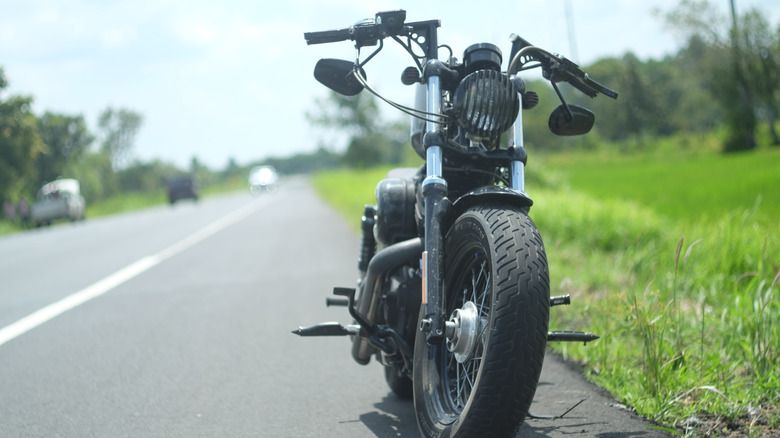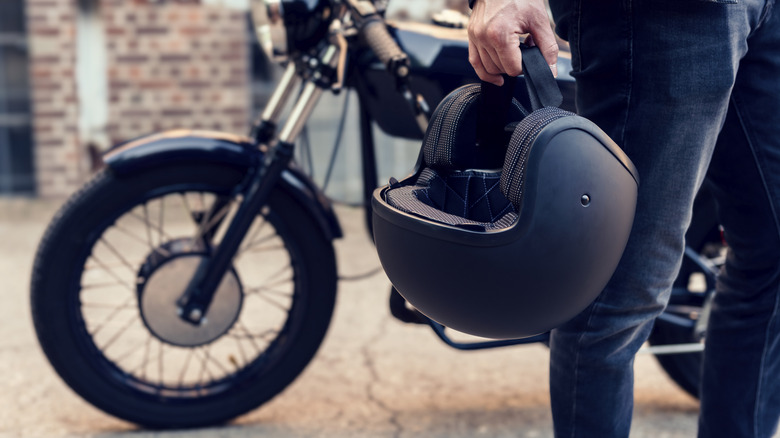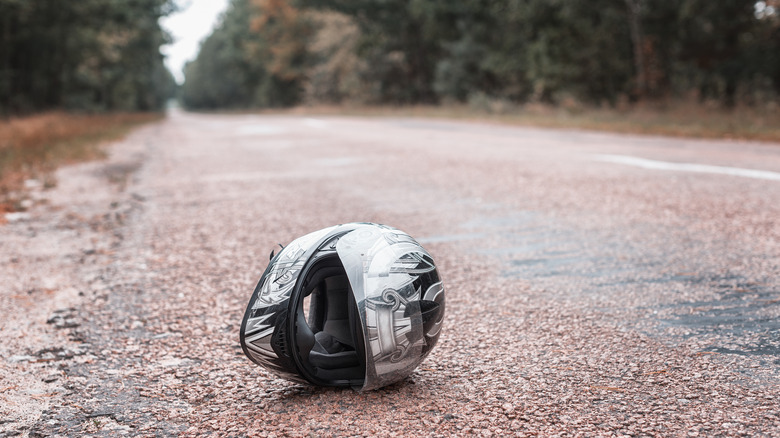Why You Should Never Ignore A Helmet On The Ground Behind A Motorcycle
Imagine the scene: You're driving down a country lane, just as the sun is beginning to set and dusk is taking hold of the trees and shrubs on either side of the road. There are no other vehicles ahead, behind you, or coming toward you on the other side of the lane. But as you turn a corner, you see a motorcycle parked in an unusual spot close to the road's edge. Its lights are off, and as you pass by, you notice that there is the reflection of something in your headlights — a helmet on the ground just behind the motorcycle's back wheel. There is no sign of the rider. So what's happened? Has the bike been abandoned? Is the rider somewhere nearby taking a rest? Have they had an accident? Or is something sinister going on?
In most cases, the answer is that the rider has placed their helmet in that location purposefully — to signal that they are in distress. It means they or their passenger may be injured or incapacitated, or there may be a mechanical failure with the motorcycle. They may simply have run out of fuel, or they might have run into another problem that makes them unable to keep going to their destination.
A long-held signal among bikers
The first motorcycles made it to America in the late 19th century, and since then, the vehicle has developed a huge culture of its own. As well as spawning several sports including track and rally racing and speedway, it has many clubs across the world dedicated to riding purely as a pleasure pursuit. And down the decades, a huge number of unwritten rules, etiquette guidelines, special signals, and gestures (such as the downward two-finger point) have emerged among riders. They reflect the community's desire for mutual safety and social cohesion, and the helmet-on-the-ground signal is a great example.
Though not particularly well known outside the motorbiking community, the placing of the rider's helmet on the ground behind a motorcycle is known to a good proportion of their fellow enthusiasts — particularly experienced riders. It's a surefire signal that the person is in distress and requesting help. Giving help to another motorcyclist is considered proper etiquette. In fact, many motorcyclists will pull over and offer assistance to any rider who appears to be in trouble, helmet on the ground or otherwise.
What to do if you see a helmet on the ground behind a motorcycle
Even though this piece of etiquette is generally only known among motorcyclists, you should still take action if you happen to spot a motorcycle helmet placed conspicuously on the ground behind a parked bike. The best thing you can do is pull over and be prepared to lend assistance to a rider who has run into trouble — whether you're a motorcyclist yourself or not. Depending on the situation, you may have to provide assistance in a number of ways. If there is no sign of the rider, it would be a good idea to check the immediate surrounding area for them, as they may be injured and trying to recover somewhere. However, you may not want to stray too far from the site in case they have gone to look for help themselves. In this case, it would be sensible to call out to see whether they are within earshot and wait in place for their return.
If the rider is there, they may ask to use your cellphone to call for medical or mechanical help, or they may require a ride somewhere. They may also ask you to fetch fuel, or just some water if they have stopped due to extreme dehydration (this is why it is always a good idea to carry a water supply while traveling). If you encounter a dehydrated rider on a hot day, even allowing them to enjoy your car's air conditioning for a time can be a godsend.
Looking for other road etiquette insights? Here's what it means when a trucker flashes their lights twice.


